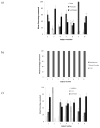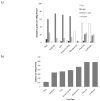Food choice in the laboratory pigeon
- PMID: 22750307
- PMCID: PMC3404163
- DOI: 10.1016/j.beproc.2012.06.005
Food choice in the laboratory pigeon
Abstract
Although food reward plays a large role in learning and behavioral experiments, there have been few studies examining the most motivating food reward for pigeons. Brown (1969) found that pigeons had a tendency to prefer peas, while Killeen et al. (1993) found pigeons to prefer peas and popcorn in Experiment 1A. We looked to further explore these options as well as expand upon the types of foods examined beyond mainly grains and seeds. Pigeons were presented with six novel foods (granulated peanuts, popping corn, freeze-dried mealworms, bread crumbs, split peas, and sunflower hearts) allocated into two sets of three food items. Once the most consumed food from each food set was determined, they were pooled together with sorghum seeds (a familiar food) to form a third set. Sunflower hearts were the most consumed of all the food items, followed by corn and granulated peanuts. We discuss the potential factors mediating consumption choice, including nutritional profile and food particle size.
Copyright © 2012 Elsevier B.V. All rights reserved.
Figures


References
-
- Brown RGB. Seed selection by pigeons. Behaviour. 1969;34:115–130.
-
- Exotic Nutrition Pet Co. Live Mealworm Information. 2009 Retrieved from http://www.exoticnutrition.com/limein.html.
-
- Moon RD, Zeigler HP. Food preferences in the pigeon (Columba livia) Physiology and Behavior. 1979;22(6):1171–1182. - PubMed
-
- Murton RK, Westwood NJ. The Foods of the Rock Dove and Feral Pigeon. Bird Study. 1966;13:130–146.
Publication types
MeSH terms
Grants and funding
LinkOut - more resources
Full Text Sources

